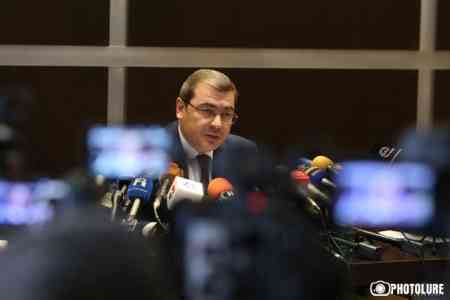


ArmInfo.The draft state budget for 2026 presented by the Armenian government, in its content, is an attempt to combine the idea of "balancing opportunities and risks." However, the document often overflows with formal ambitions without sufficient justification for how they will be translated into real economic results. Economist and former head of the State Revenue Committee of the Republic of Armenia David Ananyan shared this assessment on social media.
It is worth noting that, according to the document, Armenia's GDP growth in 2026 is projected at 5.4%, with a deflator of 3%. According to the draft, state treasury revenues are expected to reach 3 trillion 091 billion drams, of which 2 trillion 972 billion 850 million drams will be tax revenues and state duties, 20.5 billion drams will be official grants, and 97.7 billion drams will be other revenues. Community revenues in Armenia in 2026 are estimated at 347.3 billion drams (including official grants received from the state treasury).
The deficit will reach 537.5 billion drams, or 4.5% of GDP (compared to 609 billion drams, or 5.5%, in 2025). 271.3 billion drams will be allocated from external sources to cover the deficit, and 266.2 billion drams from domestic sources. As a result, the government debt/GDP ratio will increase from 50.7% to 53.5% by the end of 2026, and in absolute terms, by 810.9 billion drams, to 6 trillion 384.7 billion drams.
According to Ananyan, in terms of fiscal policy, the government is working within the framework of the "consolidation" agenda with the goal of reducing the deficit and bringing the debt to approximately 50% of GDP by 2030. This is a necessary step, but, according to the expert, the document is worryingly devoid of countercyclical components. In the event of potential shocks in external markets, Armenia will be virtually unable to respond flexibly.
The economist welcomes the policy of increasing the tax-to-GDP ratio to 25-26%. However, he points out, tax policy is still viewed primarily as administrative. No mechanisms for deep reforms of the investment environment or changes in the economic structure are proposed. "The fight against the shadow economy remains a political slogan, not a concrete set of tools," he believes.
Ananyan also notes the justification for the policy of increasing the share of capital expenditures (5-6% of GDP). But, again, he notes, priority is given to volume over quality. The real impact of road construction or infrastructure projects on economic turnover and the restoration of the industrial base is not assessed. "There's a risk that we'll end up with large budget figures but inadequate economic results," the expert writes.
Regarding socioeconomic priorities-the introduction of health insurance and the implementation of educational and social programs-Ananyan notes the prevalence of the "expenditure" approach. Social assistance is practically unrelated to programs promoting employment and increasing labor productivity. Under these circumstances, even large expenditures could become a temporary relief rather than a long-term solution, he continues.
"Defense expenditures are presented in the budget sparingly and without strategic justification. Meanwhile, for Armenia, they are a necessary condition for existence. A serious problem is the lack of transparency, inefficient procurement, and lack of connection to economic policy," the former head of the State Revenue Committee writes.
In this regard, David Ananyan believes that the presented budget contains a number of positive goals, but they are dominated by a more 'accounting' approach. If the government does not change its emphasis and focus on structural changes and qualitative results, the budget will become another 'expenditure document' rather than a strategic guide to development, he notes.
In addition to criticism, the economist also makes recommendations. In particular, he believes it is necessary to:
1. Clarify sectoral drivers. The budget should reflect which sectors will be the main sources of economic growth (IT, industry, agriculture) and what instruments will be used to stimulate them.
2. Add a countercyclical component. Automatic mechanisms must be developed that will be activated in the event of economic shocks, increasing the flexibility of fiscal policy.
3. Define results-oriented criteria. Capital and social programs should have clear key performance indicators (number of jobs, export growth, labor productivity growth), rather than simply report on expenses.
4. Link social and economic policy. Support for internally displaced and vulnerable compatriots (from Artsakh) must be combined with employment and income-boosting programs. Otherwise, the state will simply remain dependent on social payments.
5. Focus on quality. Roads, schools, and reservoirs should be viewed not as quantitative indicators, but as real tools for economic activity and development.
6. Effectively stimulate innovation. Akademgorodok and state support for high technology must be transformed into a "knowledge-production-business" chain. Without this connection, investments will not translate into competitive products.
7. Clarify defense sector programs. Weapons modernization, air defense, drones, cybersecurity. Increase procurement transparency and efficiency. Develop the local defense industry, link it with the IT sector, and focus on long-term defense infrastructure.
"These are just ideological generalizations for now; analysis of the digital and information sectors is still to come," writes former head of the State Revenue Committee of Armenia, David Ananyan.